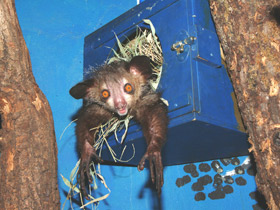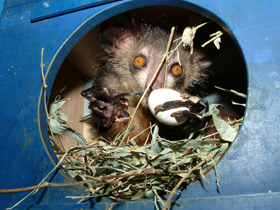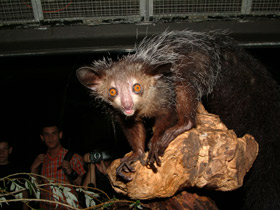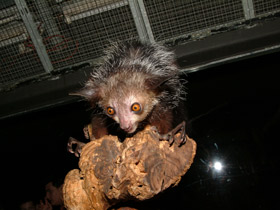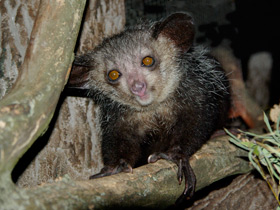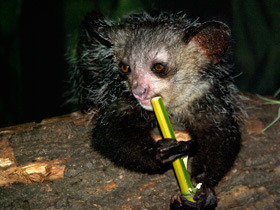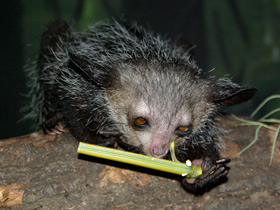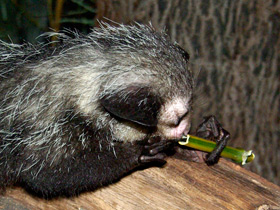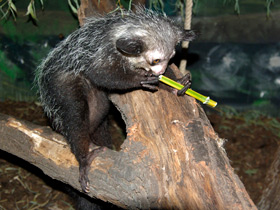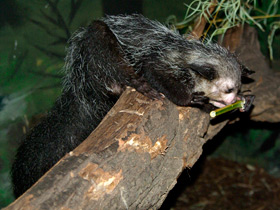The aye-aye (Daubentonia madagascariensis)
Appearance
The aye-aye (Daubentonia madagascariensis) is a long-fingered lemur, a strepsirrhine primate native to Madagascar with rodent-like teeth that perpetually grow and a special thin middle finger.
Its bizarre appearance means that it is considered to be primarily responsible for the origin of the word "lemur", Latin for "night spirit". The aye-aye is the only living representative of its genus (Daubentonia), family (Daubentonidae) and infraorder (Chiromyiformes), which makes its extreme rarity clear. Only one other species close to the aye-aye is known, the giant aye-aye (Daubentonia robusta), which became extinct less than 1000 years ago.
This small beast weighs about 3 kg and has a very distinctive appearance. The slender body of this striking primate reaches a length of 36-44 cm and is covered with stiff, straight, dark brown to black hair with a thick undercoat. Its large rounded head with a shortened facial section is adorned with huge eyes and enormous hairless ears. The incisors of Daubentonia madagascariensis are very large, curved and separated from the molars by a considerable space. The tusks are not retained after the change of milk teeth, but the incisors continue to grow throughout the animal's life.
The forelimbs of Daubentonia madagascariensis are shorter than the hind limbs and the toes have very long and somewhat bent nails. The last two joints of the middle finger are long, thin and not covered with hair. The animal uses this finger to retrieve grubs, beetles and insects from tree crevices and push them into its throat.
As in other primates, the thumb on the feet opposes the other four, but there is little opposition on the hands. The nails of the large hind toes are flat, while those of the others are claw-like. A 60 cm long fluffy tail completes the picture.
Lifestyle and peculiarities
Daubentonia madagascariensis lives at night in the tropical forests of northern Madagascar. It is extremely rare and is included in the Red List of the International Union for Conservation of Nature. The species was discovered in 1780 by the explorer Pierre Sonner on the west coast of Madagascar. The systematic position of the aye-aye was the subject of long debate. Because of its distinctive tooth structure, the animal was first classified as a rodent, but scientists later concluded that it was a distinct and divergent group of lemurs. The genus was named after the French naturalist Louis Jean-Marie Dobanton (1716-1800).
Social behaviour and reproduction
Daubentonia madagascariensis was long thought to live a solitary life and forage alone. However, researcher Elinor Sterling, who studied them in the wild, discovered that some of the animals move in pairs while foraging. If one of them wants to move on to the next tree, it will make a sound, urging its mate to follow. These pairs are maintained by the female and the male during mating games (females occupy the dominant position), and also the mother with her young.
Daubentonia madagascariensis reproduces rather slowly. The female gives birth to a single young every 2-3 years after a gestation period of about 170 days. For the young she makes a special large nest, lined with soft bedding. The calf is fed on its mother's milk for about 7 months. But even after the transition to independent feeding, it remains with its mother for quite a long time: males up to about one year, and females up to two years.
The life expectancy of Daubentonia madagascariensis in the wild is not known exactly, but in zoos they live quite long, up to 26 years.
Diet and foraging
The aye-aye is an omnivore and commonly eats seeds, nuts, fruits, nectar, plant exudates and fungi, but also xylophagous, or wood boring, insect larvae (especially cerambycid beetle larvae) and honey. Aye-ayes tap on the trunks and branches of trees at a rate of up to eight times per second, and listen to the echo produced to find hollow chambers. Studies have suggested that the acoustic properties associated with the foraging cavity have no effect on excavation behavior. Once a chamber is found, they chew a hole into the wood and get grubs out of that hole with their highly adapted narrow and bony middle fingers. The aye-aye begins foraging between 30 minutes before and three hours after sunset. Up to 80% of the night is spent foraging in the canopy, separated by occasional rest periods. It climbs trees by making successive vertical leaps, much like a squirrel. Horizontal movement is more difficult, but the aye-aye rarely descends to jump to another tree, and can often travel up to 4 km (2+1⁄2 mi) a night.
Though foraging is usually solitary, they occasionally forage in groups. Individual movements within the group are coordinated using both vocalisations and scent signals.









